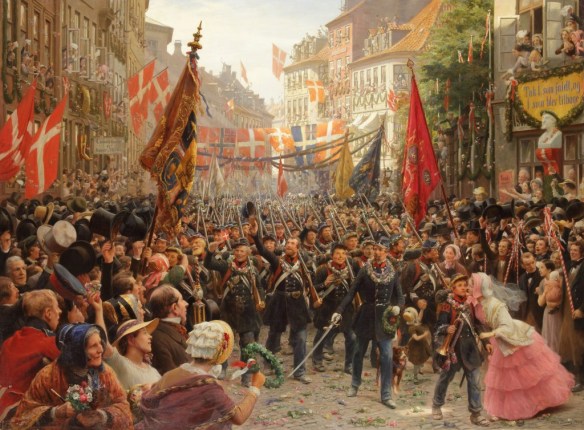Danish soldiers return to Copenhagen, 1849, by Otto Bache (1839–1927), 1894
Map of the territorial changes, without the royal Danish enclaves (German)
In 1864, the Second War of Schleswig, also known as the Danish- Prussian War, pitted the German Confederation against Denmark. Bismarck instigated the war and shrewdly gained unlikely support from Austria, in a bid to redress Prussian frustration in the First Schleswig War of 1848-51. This earlier conflict arose from the issue of who should possess the largely German provinces of Schleswig and Holstein that were under Danish control. Prussia intervened in a nationalist uprising in the region but was forced to withdraw after three years of fruitless military operations under mounting pressure from Russia, Austria, and Britain. Forced to sign the London Protocol of 1852, a settlement that reestablished the prewar status quo by confirming the Danish heir to the throne as the future monarch of the two duchies while precluding Denmark from absorbing the German provinces, the defeated Prussians were eager for revenge.
The crisis that gave Bismarck the opportunity to make up for Prussia’s embarrassing losses in the First Schleswig War began with the death of Danish king Frederik VII (1808-63), who had not left a male heir. The Prussians used this as a pretext to contest the Danish succession and the claim of the new Danish ruler, Christian IX (1818-1906), on the territories of Schleswig and Holstein. In response, the Danish king signed a new constitution that tightened Denmark’s control over Schleswig, violating the terms of the London Protocol of 1852. Furthermore, Holstein, populated almost entirely by ethnic Germans, had been held before 1806 as a German fief and was part of the German Confederation, complicating the situation. Thus, Bismarck was able to convince the confederation to join in the conflict, using German nationalist sentiment to stoke the flames of war, and even convinced the Austrians to support the war effort to “liberate” ethnic Germans in the two Danish duchies. Meanwhile, support from Europe’s great powers, so important in thwarting Prussia in the First Schleswig War, was faltering. The Russians were still reeling from their defeat in the Crimean War, and the French were not inclined to intervene on Denmark’s behalf. Only Britain, somewhat reluctantly, supported the Danes, fearing the potential Baltic naval threat from a resurgent Prussia. On December 24, 1863, at Bismarck’s urging, Saxon and Hanoverian forces occupied Holstein, supporting the claim of a local aristocrat as duke of the territory. Several days later, Prussia and Austria offered a motion in the assembly of the German Confederation authorizing them to occupy Schleswig to ensure that the Danes complied with the settlement of 1852. When the motion failed, the two powers declared their intention to operate independently in the matter.
On February 1, 1864, the Prussians invaded Schleswig after the Danish government refused an ultimatum issued by Bismarck to revoke the new constitution. Austrian forces also moved into the territory alongside the Prussians, fighting the Danes in harsh winter conditions. By mid-February the war had spilled over into Denmark, and Bismarck convinced the Austrians that the conflict presented an opportunity settle the issue once and for all. Thus, the allies declared that the protocol of 1852 was no longer valid and that the status of Schleswig and Holstein was to be determined by force of arms. Abandoned by the major powers of Europe, and assaulted by the combined forces of Prussia and Austria, the Danish defenses crumbled. Despite the success of the Danish navy, which won a narrow victory at the Battle of Heligoland over the Austrians in May, the Danish army was outnumbered almost 2 to 1 by the combined forces of the Prussians and Austrians. In addition, the Prussians were armed with the latest military equipment and held a decisive advantage in heavy artillery, pounding Danish positions with unrelenting fi re. While the outmanned Danes fought valiantly, the invaders soon overwhelmed their defenses, and by July, the Prussians occupied all of Denmark. By the summer of 1864, the war was effectively over, and on October 30, the belligerents signed the Treaty of Vienna, which ceded Schleswig to Prussia and Holstein to Austria. The Second Schleswig War had several important consequences for German history. Most important, it demonstrated the formidable power of the recently reorganized Prussian army, a force armed with state-of-the-art breech-loading rifles that gave them unprecedented fi repower. The war also brought valuable territory into the German orbit, as these productive regions, including several strategic Baltic ports, were absorbed into the Hohenzollern and Habsburg realms. The war was also the last time that the Prussians and Austrians cooperated. A conflict between the two German powers would erupt over a dispute regarding the administration of these newly conquered regions.
